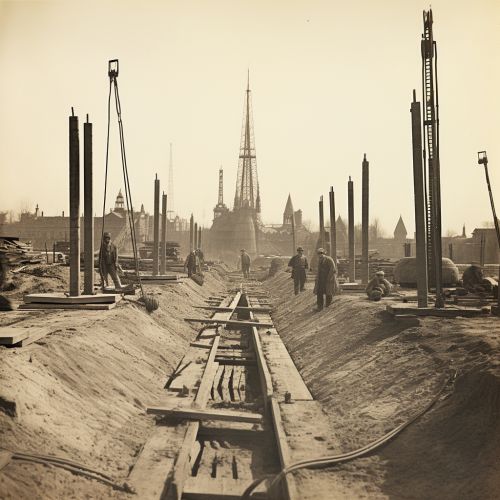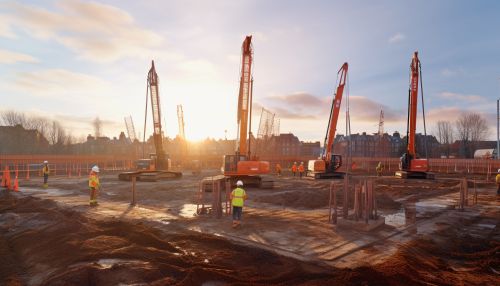Pile Foundation
Introduction
A pile foundation is a type of deep foundation that is used to transfer the load from a structure to the stronger soil layers deep below the ground surface. The pile foundation is commonly used in construction when the surface soil layer is weak and unable to support the load of the structure. This type of foundation is also used when the structure is subjected to lateral loads, such as wind or seismic forces, and the pile foundation can provide the necessary resistance.


Types of Pile Foundations
There are two main types of pile foundations, each with its own specific applications and advantages. These are end-bearing piles and friction piles.
End-Bearing Piles
End-bearing piles work on the principle that the pile is driven into the ground until it reaches a layer of soil or rock that has sufficient bearing capacity to support the load of the structure. The load of the structure is then transferred through the pile to this strong layer.
Friction Piles
Friction piles work on a different principle. Instead of transferring the load of the structure to a strong soil layer deep below the surface, friction piles transfer the load to the soil along the entire length of the pile, through friction. This is particularly useful when a strong layer of soil or rock is too deep to reach economically.
Design and Construction of Pile Foundations
The design and construction of pile foundations require a thorough understanding of the soil conditions, the type of structure to be built, and the loads that the structure will impose on the foundation. The process involves several steps, including site investigation, pile design, pile installation, and pile load testing.
Site Investigation
Site investigation is the first step in the design of pile foundations. It involves the collection of soil samples from the site and the testing of these samples to determine their physical and mechanical properties. This information is used to decide on the type of pile to be used and the depth to which it should be driven.
Pile Design
Pile design involves determining the size, length, and type of pile that will be suitable for the site conditions and the load of the structure. This involves calculations to ensure that the pile will have sufficient bearing capacity and will not fail under the loads imposed by the structure.
Pile Installation
Pile installation involves driving the pile into the ground using a pile driver. The pile driver is a machine that delivers blows to the top of the pile, driving it into the ground. The pile is driven until it reaches the required depth or until it meets sufficient resistance to support the load of the structure.
Pile Load Testing
Pile load testing is carried out to confirm that the pile has sufficient bearing capacity to support the load of the structure. This involves applying a load to the pile and measuring the settlement of the pile under this load.
Advantages and Disadvantages of Pile Foundations
Like all foundation types, pile foundations have their advantages and disadvantages. The choice of a pile foundation depends on the specific conditions of the site and the requirements of the structure.
Advantages
Pile foundations have several advantages. They can be used in areas where the surface soil is weak or has low bearing capacity. They can also be used in areas with high water tables, where other types of foundations may not be suitable. Pile foundations can also resist lateral loads and uplift forces, making them suitable for structures subjected to such forces.
Disadvantages
The main disadvantage of pile foundations is their cost. They are usually more expensive than other types of foundations due to the cost of pile driving equipment and the time required to drive the piles. Pile foundations also require a thorough site investigation and soil testing, which adds to the cost. Additionally, pile driving can cause noise and vibration, which may be a problem in urban areas.
Conclusion
Pile foundations are a versatile and effective solution for many construction challenges. They provide a means of transferring the load of a structure to the stronger soil layers deep below the ground surface, making them ideal for use in areas with weak surface soils or high water tables. While they can be more expensive than other types of foundations, their ability to resist lateral and uplift forces makes them a valuable tool in the engineer's toolkit.
